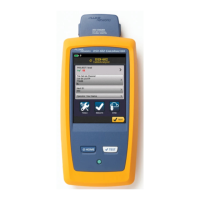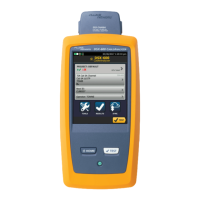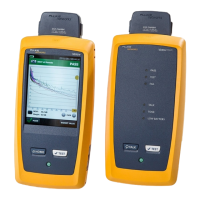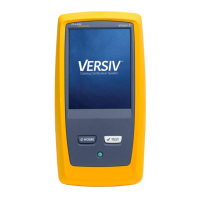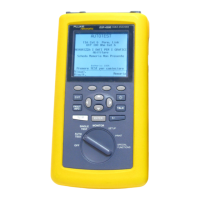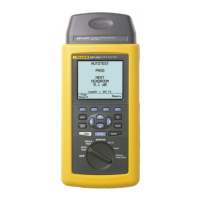Do you have a question about the Fluke DSX-600 and is the answer not in the manual?
Describes the main features of the DSX-600 CableAnalyzer, including certification, results, memory, user interface, and software applications.
Provides crucial safety warnings and precautions to prevent fire, electric shock, personal injury, and equipment damage.
Details the main tester's connectors, keys, and LED indicators, explaining their functions and locations.
Provides crucial caution for handling adapter cables to prevent damage and ensure accurate test results.
Details the use of AC adapters and lithium-ion batteries for powering the tester.
Provides instructions on how to charge the battery, including LED indicators and charging times.
Explains how to check the battery status on both the main and remote testers using icons and LEDs.
Guides users on operating the touchscreen interface with fingers or a stylus, including cautions.
Introduces a tutorial on setting up, performing, and saving twisted pair cabling certification tests.
Details setting up a twisted pair test, including selecting cable type, NVP, and shield test options.
Explains the process of attaching adapters, turning on testers, and initiating an Autotest.
Describes how to view Autotest results in different formats like WIRE MAP and PERFORMANCE.
Guides users on how to save test results, including entering a Cable ID and confirming the save action.
Explains the function of various buttons like SAVE, TEST, FIX LATER, and TEST AGAIN for test execution and saving.
Introduces the ProjX™ management system for setting up jobs, monitoring status, and organizing test results.
Lists guidelines to ensure the tester meets accuracy specifications, including software updates and calibration.
Explains the procedure for setting the reference for twisted pair cable measurements to ensure accuracy.
Describes the DIAGNOSTIC tab, providing HDTDR and HDTDX plots to help find faults after Autotest failures.
Explains how to perform an Autotest on links connected through PoE devices, including turning on AC wire map.
Explains the procedure for setting the reference for coaxial tests to establish a baseline for measurements.
Guides users on performing Autotests on coaxial cabling, covering adapter connections and test setup.
Lists common causes for failures in twisted pair tests, categorized by test type (Wire Map, Short, etc.).
Lists common causes for failures in coaxial tests, covering resistance, length, and impedance issues.
Explains the HDTDR analyzer, its plots, and how it helps find causes of return loss failures.
Describes the HDTDX analyzer, its plots, and its use in finding causes of NEXT and ACR-F failures.
Provides detailed instructions on using the measurement cursor to measure distance on HDTDR/HDTDX plots, including marking start and end points.
Guides on uploading test results from the tester or flash drive to a PC using LinkWare PC software.
Provides a step-by-step tutorial on creating a new project, including naming, operator assignment, and test setup.
Guides on setting up tests for a project, including selecting and configuring twisted pair tests.
Details connecting the tester to a wired network and signing into LinkWare Live for project management.
Explains connecting the tester to a Wi-Fi network using a USB Wi-Fi adapter and signing into LinkWare Live.
Explains how to create custom cable types for twisted pair or coaxial installations not listed in the tester.
Explains how to change the Nominal Velocity of Propagation (NVP) to improve length measurement accuracy.
Guides on setting the NVP to a specific value, typically from the manufacturer, for accurate length calculation.
Explains how to determine a cable's actual NVP by measuring its length against a known length.
Guides on creating custom outlet configurations by enabling/disabling pairs and naming them.
Explains how to update the tester's software to access new features and test limits.
Provides instructions for updating the tester's software using a PC and LinkWare PC software.
Explains how to use an updated main tester to update the software on a remote or another main tester.
Guides on updating the tester's software via LinkWare Live by downloading updates from the cloud.
Explains the importance of calibration and how to check the tester's calibration status.
Provides troubleshooting steps for common issues like unresponsive touchscreens or failure to power on.
Continues troubleshooting for incorrect test results, suggesting checks for cable type and test limit settings.
Details the measurement accuracy parameters for the DSX-600, compliant with TIA 1152 and IEC 61935-1.
Describes the main features of the DSX-600 CableAnalyzer, including certification, results, memory, user interface, and software applications.
Provides crucial safety warnings and precautions to prevent fire, electric shock, personal injury, and equipment damage.
Details the main tester's connectors, keys, and LED indicators, explaining their functions and locations.
Provides crucial caution for handling adapter cables to prevent damage and ensure accurate test results.
Details the use of AC adapters and lithium-ion batteries for powering the tester.
Provides instructions on how to charge the battery, including LED indicators and charging times.
Explains how to check the battery status on both the main and remote testers using icons and LEDs.
Guides users on operating the touchscreen interface with fingers or a stylus, including cautions.
Introduces a tutorial on setting up, performing, and saving twisted pair cabling certification tests.
Details setting up a twisted pair test, including selecting cable type, NVP, and shield test options.
Explains the process of attaching adapters, turning on testers, and initiating an Autotest.
Describes how to view Autotest results in different formats like WIRE MAP and PERFORMANCE.
Guides users on how to save test results, including entering a Cable ID and confirming the save action.
Explains the function of various buttons like SAVE, TEST, FIX LATER, and TEST AGAIN for test execution and saving.
Introduces the ProjX™ management system for setting up jobs, monitoring status, and organizing test results.
Lists guidelines to ensure the tester meets accuracy specifications, including software updates and calibration.
Explains the procedure for setting the reference for twisted pair cable measurements to ensure accuracy.
Describes the DIAGNOSTIC tab, providing HDTDR and HDTDX plots to help find faults after Autotest failures.
Explains how to perform an Autotest on links connected through PoE devices, including turning on AC wire map.
Explains the procedure for setting the reference for coaxial tests to establish a baseline for measurements.
Guides users on performing Autotests on coaxial cabling, covering adapter connections and test setup.
Lists common causes for failures in twisted pair tests, categorized by test type (Wire Map, Short, etc.).
Lists common causes for failures in coaxial tests, covering resistance, length, and impedance issues.
Explains the HDTDR analyzer, its plots, and how it helps find causes of return loss failures.
Describes the HDTDX analyzer, its plots, and its use in finding causes of NEXT and ACR-F failures.
Provides detailed instructions on using the measurement cursor to measure distance on HDTDR/HDTDX plots, including marking start and end points.
Guides on uploading test results from the tester or flash drive to a PC using LinkWare PC software.
Provides a step-by-step tutorial on creating a new project, including naming, operator assignment, and test setup.
Guides on setting up tests for a project, including selecting and configuring twisted pair tests.
Details connecting the tester to a wired network and signing into LinkWare Live for project management.
Explains connecting the tester to a Wi-Fi network using a USB Wi-Fi adapter and signing into LinkWare Live.
Explains how to create custom cable types for twisted pair or coaxial installations not listed in the tester.
Explains how to change the Nominal Velocity of Propagation (NVP) to improve length measurement accuracy.
Guides on setting the NVP to a specific value, typically from the manufacturer, for accurate length calculation.
Explains how to determine a cable's actual NVP by measuring its length against a known length.
Guides on creating custom outlet configurations by enabling/disabling pairs and naming them.
Explains how to update the tester's software to access new features and test limits.
Provides instructions for updating the tester's software using a PC and LinkWare PC software.
Explains how to use an updated main tester to update the software on a remote or another main tester.
Guides on updating the tester's software via LinkWare Live by downloading updates from the cloud.
Explains the importance of calibration and how to check the tester's calibration status.
Provides troubleshooting steps for common issues like unresponsive touchscreens or failure to power on.
Continues troubleshooting for incorrect test results, suggesting checks for cable type and test limit settings.
Details the measurement accuracy parameters for the DSX-600, compliant with TIA 1152 and IEC 61935-1.
| Model | DSX-600 |
|---|---|
| Type | Cable Analyzer |
| Testing Standards | TIA, ISO/IEC |
| Battery Life | Up to 10 hours |
| Operating Temperature | 0 °C to 50 °C |
| Storage Temperature | -20 °C to 60 °C |
| Test Capabilities | Troubleshooting |
| Standards Compliance | ISO 11801 |
| Display | Color |
